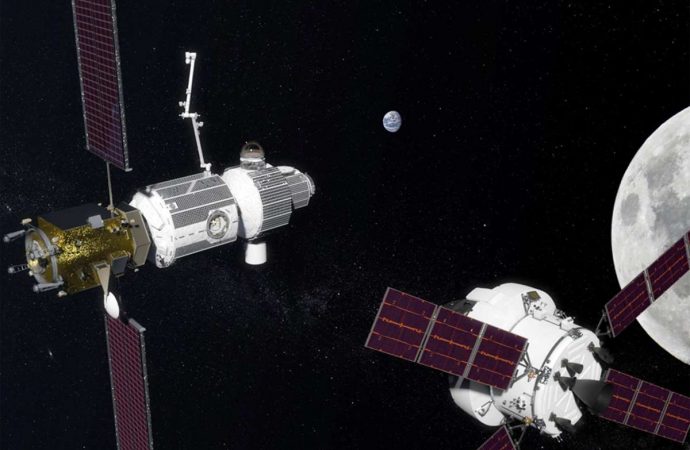Imagine, a few years from now, looking up into the night sky and seeing a full moon, brightly illuminating the landscape in front of you.
Source: Houston Chronical
Now imagine a mini-space station orbiting that moon, harboring astronauts for 30-to-60-day stints as they travel back and forth to the lunar surface.
If NASA has its way, this will not be science fiction. This will be a reality.
It’s called the Lunar Orbital Platform-Gateway, an outpost near the moon that signifies just one way President Donald Trump is pushing for a more robust human exploration program during his tenure as president. And after Vice President Mike Pence in March directed NASA to put humans back on the moon four years early — in 2024 instead of 2028 — the Gateway will play an even bigger role in this exploration plan.
“The Gateway is our ability to go to the moon fast, for sure,” NASA Administrator Jim Bridenstine said during the 2019 Space Symposium in April. “The first elements of the Gateway … are focused exclusively on getting humans to the surface.”
Under NASA’s current plan, the first phase of the Gateway — the power and propulsion element — would launch in 2022. This element is important because it will keep the Gateway in position orbiting the moon, as well as provide reliable communication between the Gateway and Earth.
For now, NASA is looking over industry proposals for the first phase and expects to pick one in May.
Next would be the habitation element, currently scheduled to launch in 2024. This section of the station would allow astronauts to live and work there for up to two months at a time, conducting scientific experiments both near and on the moon.
NASA plans to launch both these elements on the back of a commercial rocket, though which company would provide that rocket still is unclear.
International collaborations
The launch dates, however, are likely to change given Pence’s recent announcement. NASA probably will need the habitation element in orbit earlier than 2024 if it wants astronauts to touch down on the surface that year.
Bridenstine in April said NASA officials are working on a plan to meet Pence’s directive and a new budget that would allow them to do so. The current budget proposal, which includes a $500 million cut in funding for the space agency, was operating under the assumption that a human lunar surface mission would not happen until 2028.
This year’s budget proposal seeks $821 million for continued work on the Gateway, specifically the power and propulsion element. In the current budget year, Congress has allocated $450 million to NASA for the program.
Even as the budgets still are being worked out, NASA has been charging ahead on securing international partners for the Gateway. Canada earlier this year became the first country to sign on as a collaborator, promising to build a robotic arm to be used on the Gateway. Called Canadarm3, it will be the successor to one now in use on the International Space Station.
“Canadarm was essential to the Space Shuttle, Canadarm2 built the International Space Station, so it’s only fitting and right that the arm that will repair and maintain the lunar gateway will yet again be made in Canada by Canadians,” Canadian Prime Minister Justin Trudeau said in February.
The European Space Agency also is looking to be a part of the new moon station. Though ESA has not officially signed on, David Parker, the ESA’s director of human and robotic exploration, said in March that “the lunar Gateway is the next big step in human exploration and we are working to make Europe a part of it.”
Onward and upward
The Gateway also will be equipped with an airlock, enabling crew members to conduct spacewalks, and eventually a logistics module that would allow for cargo resupply deliveries and future commercial use. Current plans stipulate that the Gateway would be resupplied by commercial companies, as they do for the International Space Station.
Though the Gateway is vital for a return to the moon, NASA also hopes that it will act as a stop-over for astronauts eventually traveling to Mars.
“It will drive our activity with commercial and international partners and help us explore the moon and its resources,” said Bill Gerstenmaier, associate administrator of NASA’s Human Exploration and Operations Mission Directorate, last year. “We will ultimately translate that experience toward human missions to Mars.”

































Leave a Comment
You must be logged in to post a comment.